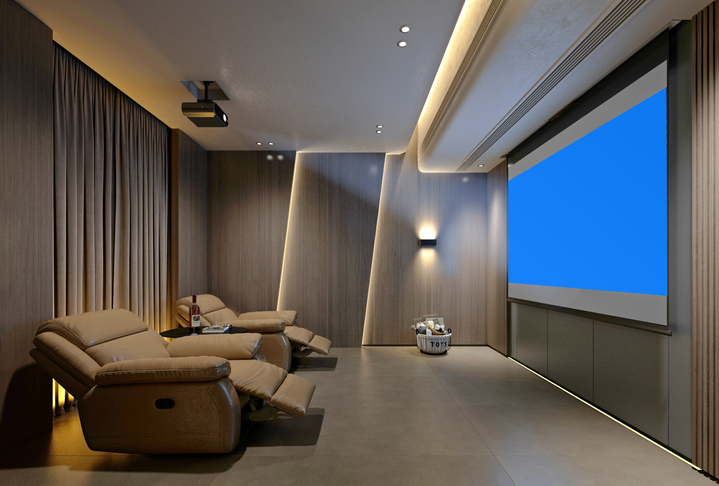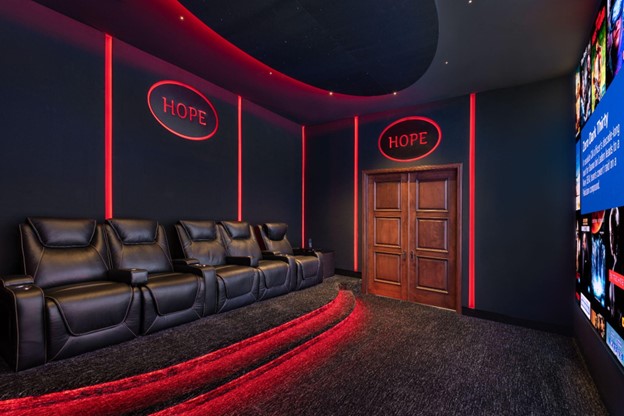Home Theater 101: Every Little Thing You Need to Know for a Cinematic Experience in your home
Developing a home theater that equals the cinematic experience of an industrial theater entails mindful consideration of several parts, consisting of display selection, sound systems, and area format. Each element plays an essential duty in achieving the wanted ambiance and capability. Whether you are pondering the perfect display dimension or the complexities of border audio, comprehending these principles is important. As we explore these vital parts, it comes to be noticeable that the selections made can significantly impact your overall viewing experience, leaving one to ponder how these decisions will form your personal cinema.
Selecting the Right Screen
When establishing a home cinema, picking the appropriate display can make or break the watching experience - tampa home theater. The screen acts as the centerpiece of your setup, influencing picture quality, watching angles, and general visual. Trick variables to consider consist of display size, resolution, and type
First, identify the suitable display size based on your room measurements and seating distance. Next off, pick in between different display kinds, such as fixed-frame, motorized, or retracting screens, each offering distinct advantages.
Resolution is one more important factor. For a genuinely immersive experience, take into consideration a screen created for 4K or perhaps 8K content, ensuring sharpness and clearness. In addition, consider the screen's gain, which influences illumination and contrast; a greater gain can enhance brightness in well-lit spaces, while a reduced gain may be preferable for darker environments.
Choosing Audio Equipment
Audio equipment is a vital element of any type of home cinema system, dramatically enhancing the overall viewing experience. The choice of audio gear can figure out the depth, clearness, and immersion of noise, critical for developing a motion picture ambience.
When picking audio tools, take into consideration a border audio system, which typically consists of a receiver, numerous speakers, and a speaker. A 5.1 or 7.1 channel system is recommended, where the first number stands for the audio speakers and the 2nd the subwoofer, providing an immersive soundscape. The receiver is the heart of the system, handling sound and video signals, and ought to sustain contemporary formats like Dolby Atmos for an enhanced spatial experience.
Quality speakers are important; search for models that supply a balanced noise profile with good bass feedback. Floor-standing speakers can create richer sound, while shelf choices conserve area. Furthermore, consider cordless choices for convenience of installment, although wired systems usually provide premium efficiency.

Ideal Seating Arrangements
Producing an ideal home theater experience pivots significantly on optimal seating plans. The plan of seats plays an important function in both comfort and checking out quality, directly influencing the overall cinematic experience.
First, think about the screen dimension and watching distance. An usual standard is to place seats at a distance approximately 1.5 to 2.5 times the angled dimension of the screen. This makes sure an immersive experience without stressing the eyes.
Next, altitude is essential. The back rows should be directory higher than the front to avoid obstructions if your seats is in a tiered format. For level seats, make sure that the front row is not as well near the display, and that every person has a clear line of view.
Furthermore, consider the setup in regards to social dynamics. Group seats can improve the communal experience, while specific seats may be preferred for personal viewing.

Finally, prioritize comfort with ergonomic seats that supports extensive viewing durations. Integrating recliners or cushioned seats can substantially enhance the experience, making the home theater a preferred location for both enjoyment and leisure.
Lighting and Atmosphere
Reliable lighting and ambiance are necessary elements of a well-designed home movie theater, as they dramatically influence the seeing experience. The right illumination can improve the motion picture feel, while bad selections can diminish it. For optimal outcomes, take into consideration a layered illumination strategy that consists of ambient, task, and accent lighting.
Ambient illumination supplies basic lighting, making sure that the room is not completely dark, which can stress the eyes. Dimmer switches are highly recommended, enabling modifications based upon the material being checked out. Job lights, such as wall sconces or flooring lights, supplies useful lighting for activities like reading or navigating the space without interrupting the total ambience.
Accent illumination can be made use of to highlight building functions or produce prime focus, including deepness and rate of interest to the room. LED strip lights behind displays or along racks can give a refined glow that enhances the visual experience without overwhelming the audience.

Wiring and Installation Tips
A tactical electrical wiring setup is vital for accomplishing ideal efficiency in your house cinema system. Appropriate electrical wiring not only makes sure high-grade sound and video signals but also improves the total visual of your area. Begin by drawing up your format, identifying where each element will be positioned, including your screen, speakers, and receiver.
When selecting wires, focus on top quality, properly evaluated wiring to lower signal loss. HDMI cable televisions need to be made use of for video clip links, while speaker cable should match the requirements of your speakers and look at here now amplifier. Choose in-wall ranked cords to follow safety and security standards and keep a tidy appearance.

Conclusion
In summary, producing a phenomenal home theater experience requires careful consideration of different aspects, consisting of display choice, audio tools, seating arrangements, illumination, and electrical wiring. By prioritizing these aspects, a motion picture environment can be effectively duplicated, enabling for immersive checking out experiences that measure up to traditional theater setups.
Producing a home movie theater that rivals the motion picture experience of an industrial theater entails cautious factor to consider of multiple elements, consisting of display selection, sound systems, and space design.When setting up a home theater, choosing the ideal screen can make or break the viewing experience. Next off, select between different screen kinds, such as fixed-frame, mechanized, or retractable screens, each offering distinctive benefits. For a genuinely immersive experience, think about a display created for 4K or also 8K material, guaranteeing sharpness and quality.In recap, producing an exceptional home cinema experience needs mindful factor to consider of different elements, consisting of screen selection, Read Full Article audio equipment, seating setups, lighting, and circuitry.
Comments on “Top Home Theater Tampa Installers Offering Personalized Solutions”